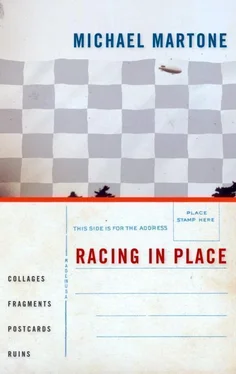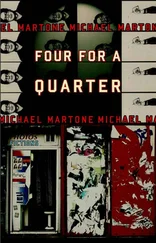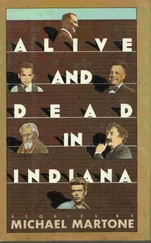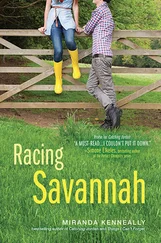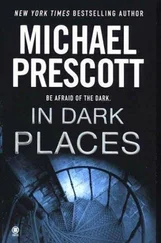We Didn't Speak of Reddy Kilowatt
My grandfather worked as a meter reader for the municipal electric utility, City Light and Power, until it was sold to the regional for-profit company, Indiana and Michigan, or I&M, in a deal he regarded as shady.
I&M had always had a presence in Fort Wayne. That company owned the electric interurbans that ran all over Indiana early in the century. I&M maintained the high-tension transmission lines that brought much of the electricity into the city to be sold by City Light. There was a billboard near I&M's building, shielding the lot where it kept the hulks of transformers, gen erators, and cable spools. The billboard was by the corner of Spy Run and State, and my grandfather had to read its meter. The sign, of course, was lit all the time, and sometimes parts of it moved. The billboard, advertising the advantages of electric power, utilized a character named Reddy Kilowatt-a stick figure made up of a skeleton of lightning with a light bulb head and a light bulb nose and socket outlets for ears.
My grandfather despised Reddy Kilowatt, and we weren't to speak of him. Not that we would have even noticed its existence without the focus of my grandfather's rage. Reddy Kilowatt would have been just another cartoon on the landscape of cartoons I wandered through as a child. Still, we knew the days Grandfather read the meter on the sign. He would come home restless and unsettled, drink an extra Pepsi on the back porch to facilitate his belching.
After City Light was bought out and he retired, my grandfather took elaborate routes through the city to avoid passing the sign. This was a difficult thing to do since State was the main east-to-west thoroughfare on the north side of town. There were times that passing the sign was unavoidable and the traffic light at the corner of Spy Run and State always stopped you. Grandfather seethed in the car as Reddy Kilowatt, his crimped kinetic arm waving back and forth, loomed before him.
Stopped at the same light on our journey across town to visit my grandparents, my family contemplated Reddy Kilowatt, who might then be wearing earmuffs for winter or sunglasses during the summer, promoting electric heat or air conditioning. My mother always mentioned, her father not being present to hear, how Daddy was looking more and more like that Reddy Kilowatt-the wiry frame, the round mostly bald head with the tiny white shock of hair at his crown. "Don't tell him I said so, please!" she said as the light changed.
Hoosier Defines Itself
My uncle went to graduate school at Tennessee to study health. He got a government grant to run a study in the hope of demonstrating the validity of his thesis: To know the deleterious effects of obesity would aid in weight reduction. He had two groups of dieters. The control group simply followed the menus and exercise suggestions provided by a national weight reduction company. The subjects in the experiment also had to follow the diet and in addition complete a rigorous course detailing graphically and statistically the dangers of fat. To his surprise, my uncle proved that while the control group modestly lost pounds, the educated group effortlessly gained a ton. Traumatized by the detailed information they were receiving, they nervously ate in order not to think about what was happening to their bodies as they ate.
While in Knoxville, my uncle sent me a poster I hung on the wall of my bedroom. The drawing depicted a team portrait of the mascots of the Southeastern Conference, their eponymous heads bobbing above the various team football uniforms. There were two Bulldogs, a Hog, and several military combatantsMississippi's Rebel, Vanderbilt's Commodore, and Tennessee's own Volunteer. Alabama's Tide was, strangely, an Elephant that would make no sense until, years later, I moved to Tuscaloosa and learned it derived from the historical confluence of a Rose Bowl game and a local luggage company. Right after my uncle's gift, my father gave me the complementary poster representing the Big Ten, and I taped it next to the first one. I liked to think of the two portraits as my uncle's two groups of dieters.
The head of the Hoosier was rendered as that of a bumpkin, the dictionary definition after all, the same definition that Dan Quayle once on the floor of the United States Senate argued to legally change. The Hoosier on the poster showed up as a yokel, a rural rube with a fraying straw hat atop his rusty head of hair. He had vacant blue eyes and freckles, big lips and buckteeth that gnawed on a bent straw of a wheat stalk or weed stem. This Hoosier, even wearing a big-shouldered football uniform, not the requisite blue denim bib overalls, didn't look very competitive surrounded by the vicious menagerie of Wildcat, Badger, and Wolverine.
There is a whole class of mascots that suffer in this modern era of corporate corporeal identity. Look at the Buckeye looking like an eyeball with eyes. Adjectives get attached. Hurryin' was wed to Hoosier. Or weapons are issued, a pitchfork, say, that arms the Hoosier as an animated American Gothic. For a while there, the Indiana mascot metamorphed into a bison. I believe it derived from the state's seal, in which a pioneer with an axe fells a tree while the silhouette of a bison lights out for the territories. In the end Hoosier is just what it is. It is the word itself, its own mascot. One year, perhaps the same year native son Quayle rose in the Senate, the state tried to change the motto on the license tags from Hoosier State to Heritage State and was met with near insurrection. No one really knows what a Hoosier is, but not knowing, as my uncle proved, has its own logic. A Hoosier is a Hoosier is a Hoosier.
The State Drink of Wisconsin
The state bird of Wisconsin is the robin. The state flower of Wisconsin is the wood violet. The state tree of Wisconsin is the sugar maple. The state animal of Wisconsin is the badger. The state wild animal of Wisconsin is the white-tailed deer. The state domesticated animal of Wisconsin is the dairy cow and the various breeds-Holstein, Brown Swiss, Guernsey, Jersey, etc.-take yearly turns. The state fish of Wisconsin is the muskellunge. The state insect of Wisconsin is the honeybee. The state mineral of Wisconsin is galena. The state rock of Wisconsin is red granite. The state soil of Wisconsin is antigo silt loam. The state symbol of peace of Wisconsin is the mourning dove. The state of Wisconsin is undecided on the state of Wisconsin's drink. The legislature continues to argue the issue. Beer could be the state drink of Wisconsin. Milk could be the state drink of Wisconsin. Or both beer and milk.
Touchdown Jesus
My father liked to take me to football games at Notre Dame. He liked to point out how gold the gold on the helmets of The Fighting Irish was, how they were as gold as the gold on the dome of the big building on the campus we could see from the stadium. Navy's helmets were gold and Pitt's helmets were gold but not as gold as Notre Dame's gold helmets. I saw O. J. Simpson play in South Bend. We always sat in the end zone, and I remember watching him hauling in the kickoff ball and starting his sprint up the field right before us. I saw Roger Staubach and Navy in a snowstorm. Crushed tight together in the stands, everyone wore heavy wool coats before the coming of down parkas and Gore-Tex. I was there when Dan Devine's team changed its uniform to the green jerseys from the blue. The entire stadium went crazy seeing this brand new team emerge from the tunnel. And I remember when Notre Dame built the library beyond the other end of the stadium and finished off the nine-story facade with a mosaic of a beatific Christ, His arms raised above His head, in the jubilant gesture of the referee signaling a score. He hovered, it seemed, above the goal posts, above the thronging crowd, above the teeming stadium, the Goodyear blimp drifting above His head, exhorting us all. Touchdown! Touchdown! Touchdown!
Читать дальше
